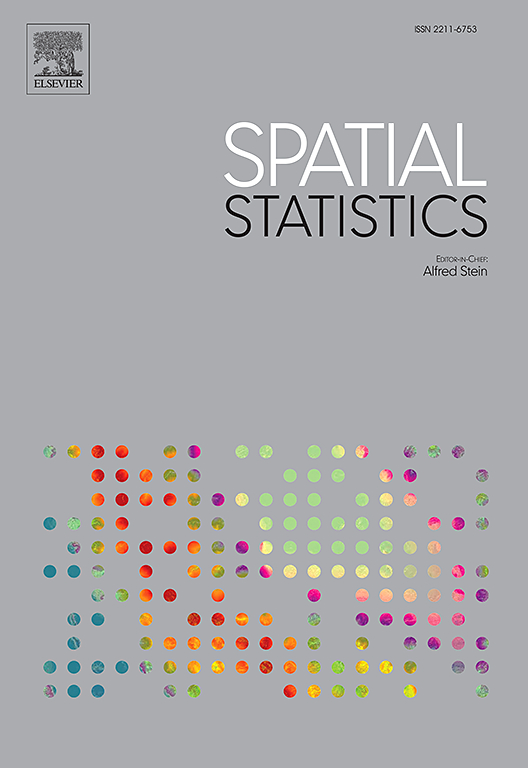A spatial autoregressive graphical model
IF 2.5
2区 数学
Q3 GEOSCIENCES, MULTIDISCIPLINARY
引用次数: 0
Abstract
Within the statistical literature, a significant gap exists in methods capable of modelling asymmetric multivariate spatial effects that elucidate the relationships underlying complex spatial phenomena. For such a phenomenon, observations at any location are expected to arise from a combination of within- and between-location effects, where the latter exhibit asymmetry. This asymmetry is represented by heterogeneous spatial effects between locations pertaining to two different categories, that is, a feature inherent to each location in the data, such that based on the feature label, asymmetric spatial relations are postulated between neighbouring locations with different labels. Our novel approach synergises the principles of multivariate spatial autoregressive models and the Gaussian graphical model. This synergy enables us to effectively address the gap by accommodating asymmetric spatial relations, overcoming the usual constraints in spatial analyses. However, the resulting flexibility comes at a cost: the spatial effects are not identifiable without either prior knowledge of the underlying phenomenon or additional parameter restrictions. Using a Bayesian-estimation framework, the model performance is assessed in a simulation study. We apply the model on intercropping data, where spatial effects between different crops are unlikely to be symmetric, in order to illustrate the usage of the proposed methodology. An R package containing the proposed methodology can be found on https://CRAN.R-project.org/package=SAGM.
空间自回归图形模型
在统计文献中,在能够模拟非对称多元空间效应的方法上存在着显著的差距,这些方法阐明了复杂空间现象背后的关系。对于这种现象,任何位置的观测结果都可能是由位置内效应和位置间效应的组合引起的,其中后者表现出不对称性。这种不对称表现为属于两个不同类别的位置之间的异构空间效应,即数据中每个位置固有的特征,因此基于特征标签,假设具有不同标签的相邻位置之间存在不对称空间关系。我们的新方法协同多元空间自回归模型和高斯图形模型的原理。这种协同作用使我们能够通过适应不对称的空间关系来有效地解决差距,克服空间分析中的通常限制。然而,由此产生的灵活性是有代价的:如果没有对潜在现象或附加参数限制的先验知识,则无法识别空间效应。利用贝叶斯估计框架,对模型的性能进行了仿真研究。我们将该模型应用于间作数据,其中不同作物之间的空间效应不太可能对称,以说明所提出方法的使用。包含建议的方法的R包可以在https://CRAN.R-project.org/package=SAGM上找到。
本文章由计算机程序翻译,如有差异,请以英文原文为准。
求助全文
约1分钟内获得全文
求助全文
来源期刊

Spatial Statistics
GEOSCIENCES, MULTIDISCIPLINARY-MATHEMATICS, INTERDISCIPLINARY APPLICATIONS
CiteScore
4.00
自引率
21.70%
发文量
89
审稿时长
55 days
期刊介绍:
Spatial Statistics publishes articles on the theory and application of spatial and spatio-temporal statistics. It favours manuscripts that present theory generated by new applications, or in which new theory is applied to an important practical case. A purely theoretical study will only rarely be accepted. Pure case studies without methodological development are not acceptable for publication.
Spatial statistics concerns the quantitative analysis of spatial and spatio-temporal data, including their statistical dependencies, accuracy and uncertainties. Methodology for spatial statistics is typically found in probability theory, stochastic modelling and mathematical statistics as well as in information science. Spatial statistics is used in mapping, assessing spatial data quality, sampling design optimisation, modelling of dependence structures, and drawing of valid inference from a limited set of spatio-temporal data.
 求助内容:
求助内容: 应助结果提醒方式:
应助结果提醒方式:


